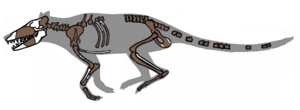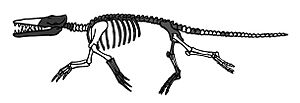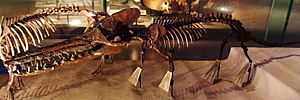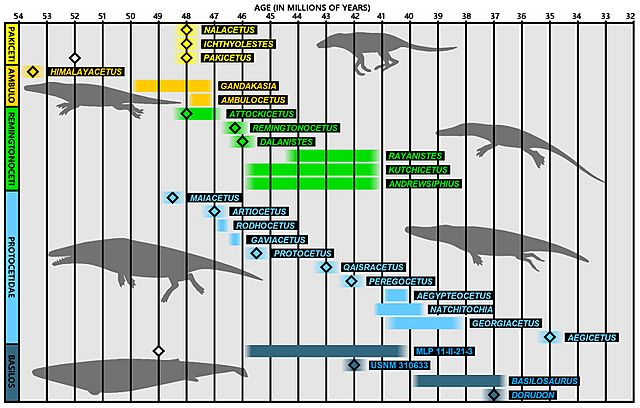Archaeoceti facts for kids
Quick facts for kids ArchaeocetiTemporal range: Eocene–Oligocene
|
|
|---|---|
 |
|
| Cynthiacetus and Ambulocetus skeletons | |
| Scientific classification | |
| Kingdom: | |
| Phylum: | |
| Class: | |
| Order: | |
| Suborder: |
†Archaeoceti
|
The Archaeoceti are a group of ancient whales. Their name means 'ancient whales'. They lived a long, long time ago, from about 55 to 23 million years ago. These were the very first whales to appear on Earth. They also include the first whales that could live both in water and on land. Because of this, Archaeoceti are the ancestors of all modern whales, including the two main types we see today: Mysticeti (baleen whales) and Odontoceti (toothed whales).
These ancient whales first appeared in the shallow waters between India and Asia. This was about 55 to 45 million years ago. Scientists have found fossils of about 30 different species. Many of these species had already adapted to live fully in the ocean. Later on, around 36 to 35 million years ago, modern whale features like echolocation (using sound to find things) and filter-feeding (straining food from water) began to appear.
All Archaeoceti fossils found from 55 to 48 million years ago are only from India and Pakistan. But by 41 to 34 million years ago, these whales were found all over the world. This includes places like North America, Egypt, New Zealand, and Europe. They probably traveled along coastal waters to reach these far-off places. They might have gone around Africa or across the ancient Tethys Sea.
The Archaeoceti group is called "paraphyletic." This means it's a group that includes an ancestor but not all of its descendants. In this case, Archaeoceti gave rise to the two modern types of whales, but the group itself doesn't include those modern whales.
Contents
What Did Ancient Whales Look Like?
Pakicetids: Whales That Walked
The Pakicetids were the oldest and most basic type of ancient whales. Scientists first realized they were whales in 1980. These animals had long, thin legs and a long, narrow tail. They were about the size of a modern wolf. Their fossils have only been found in freshwater streams in India and Pakistan. This suggests they probably walked in shallow water rather than swimming deeply.
Scientists have found many Pakicetid fossils, but mostly just skulls, teeth, and jaw pieces. No full skeletons have been discovered yet. Their teeth varied a lot. Some had teeth like modern fish-eaters, while others had teeth like hyenas. This means they might have hunted other animals or eaten dead ones. Even though their skulls and teeth don't look like modern whales, their ear bones show they are related to whales.
Ambulocetids: The Walking Whales
The next group of whales to appear were the Ambulocetids. These were large, crocodile-like creatures with big feet and strong tails. They were already fully aquatic, meaning they lived in water. Fossils show they lived in coastal areas. Their heavy bones suggest they were ambush hunters, waiting for prey, rather than fast swimmers. Like Pakicetids, their fossils are only found in Pakistan and India. The oldest known whale, Himalayacetus, is an Ambulocetid. It is thought to be about 53.5 million years old.
One nearly complete fossil of Ambulocetus natans has given us a lot of information. This animal was about the size of a male sea lion. It had a large head with a long snout and strong, worn teeth. Its lower jaw had a special soft tissue that helped it hear underwater, similar to modern toothed whales. Its eyes were on top of its head but faced sideways. Ambulocetus had strong muscles in its head, neck, and back. Its tail was long and did not have a fluke (the flat tail fin of modern whales). Its hind legs were short but had long feet. Its front legs were also short and had five small hooves. Ambulocetus probably swam by kicking its hind feet, like a modern otter. It likely couldn't support its own weight on land. It was probably an ambush hunter, like crocodiles today.
Remingtonocetids: Whales That Listened
The Remingtonocetids had short limbs and a strong, powerful tail with flattened bones. Their long snouts, tiny eyes, and ear shape suggest they had poor eyesight. Hearing was likely their most important sense. These fossils are also only found in Pakistan and India. They lived in cloudy coastal waters. While they could probably still go on land, they seemed to use their tails for swimming.
Many Remingtonocetid fossils have been found, but mostly just skulls and jaws. They varied in size, from as small as Pakicetus to as large as Ambulocetus. They had longer snouts than other ancient whales, and their skull shapes also varied, probably because they ate different things. Their eyes were small, but their ears were large and far apart. This suggests they relied heavily on hearing underwater. The few body fossils found suggest they had a long neck and large hind limbs that could support their weight on land.
Protocetids: Spreading Across Oceans
The Protocetids were a diverse group found in both Africa and America. They had hind limbs and strong tails, showing they were powerful swimmers. They spread across Earth's oceans between 47 and 41 million years ago. This was a big step in whale evolution. They had long snouts and large eyes. Their nasal opening was higher on their head than in earlier whales. This means they could breathe with their head held flat, like modern whales. This was an early step towards having a blowhole on top of the head. Their teeth varied, but they were starting to change towards the simpler teeth of modern whales. They were probably active hunters. Their hind limbs were smaller, and in some species, their pelvis was not connected to their backbone. This suggests their hind limbs could no longer support their body weight on land.
Basilosaurids: Fully Aquatic Whales
Basilosaurids had tiny hind limbs and front limbs shaped like flippers. They were fully aquatic, meaning they lived only in the ocean. They became the dominant predators in the oceans. However, they still didn't have echolocation or the baleen plates that modern baleen whales use for filter-feeding. Basilosaurids are the oldest fully aquatic whales for which we have complete skeletons. They show many adaptations for life in the water. For example, their neck bones were short, and their tail had a special bone that shows they had a fluke. Their shoulder blades were wide, and their hind limbs were very tiny.
Whale Family Tree
| Cetartiodactyla |
|
||||||||||||||||||||||||||||||||||||||||||||||||
Images for kids
See also
 In Spanish: Archaeoceti para niños
In Spanish: Archaeoceti para niños

















